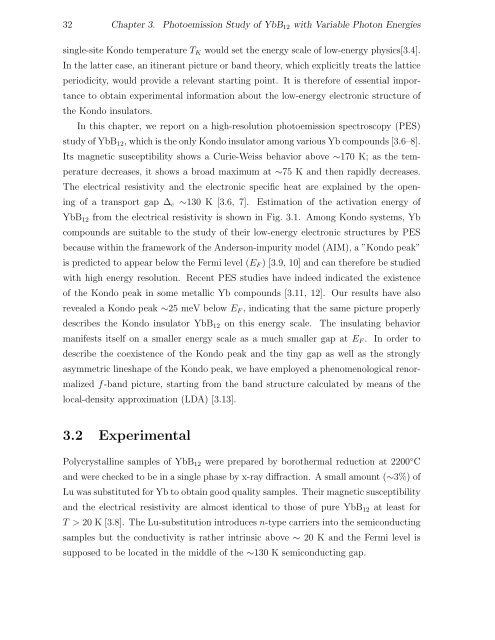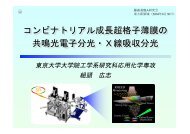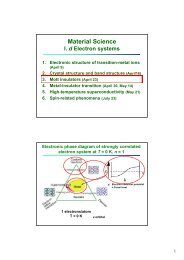Thesis High-Resolution Photoemission Study of Kondo Insulators ...
Thesis High-Resolution Photoemission Study of Kondo Insulators ...
Thesis High-Resolution Photoemission Study of Kondo Insulators ...
You also want an ePaper? Increase the reach of your titles
YUMPU automatically turns print PDFs into web optimized ePapers that Google loves.
32 Chapter 3. <strong>Photoemission</strong> <strong>Study</strong> <strong>of</strong> YbB12 with Variable Photon Energies<br />
single-site <strong>Kondo</strong> temperature TK would set the energy scale <strong>of</strong> low-energy physics[3.4].<br />
In the latter case, an itinerant picture or band theory, which explicitly treats the lattice<br />
periodicity, would provide a relevant starting point. It is therefore <strong>of</strong> essential importance<br />
to obtain experimental information about the low-energy electronic structure <strong>of</strong><br />
the <strong>Kondo</strong> insulators.<br />
In this chapter, we report on a high-resolution photoemission spectroscopy (PES)<br />
study <strong>of</strong> YbB12, which is the only <strong>Kondo</strong> insulator among various Yb compounds [3.6–8].<br />
Its magnetic susceptibility shows a Curie-Weiss behavior above ∼170 K; as the temperature<br />
decreases, it shows a broad maximum at ∼75 K and then rapidly decreases.<br />
The electrical resistivity and the electronic specific heat are explained by the opening<br />
<strong>of</strong> a transport gap ∆c ∼130 K [3.6, 7]. Estimation <strong>of</strong> the activation energy <strong>of</strong><br />
YbB12 from the electrical resistivity is shown in Fig. 3.1. Among <strong>Kondo</strong> systems, Yb<br />
compounds are suitable to the study <strong>of</strong> their low-energy electronic structures by PES<br />
because within the framework <strong>of</strong> the Anderson-impurity model (AIM), a ”<strong>Kondo</strong> peak”<br />
is predicted to appear below the Fermi level (EF ) [3.9, 10] and can therefore be studied<br />
with high energy resolution. Recent PES studies have indeed indicated the existence<br />
<strong>of</strong> the <strong>Kondo</strong> peak in some metallic Yb compounds [3.11, 12]. Our results have also<br />
revealed a <strong>Kondo</strong> peak ∼25 meV below EF , indicating that the same picture properly<br />
describes the <strong>Kondo</strong> insulator YbB12 on this energy scale. The insulating behavior<br />
manifests itself on a smaller energy scale as a much smaller gap at EF . In order to<br />
describe the coexistence <strong>of</strong> the <strong>Kondo</strong> peak and the tiny gap as well as the strongly<br />
asymmetric lineshape <strong>of</strong> the <strong>Kondo</strong> peak, we have employed a phenomenological renormalized<br />
f-band picture, starting from the band structure calculated by means <strong>of</strong> the<br />
local-density approximation (LDA) [3.13].<br />
3.2 Experimental<br />
Polycrystalline samples <strong>of</strong> YbB12 were prepared by borothermal reduction at 2200◦C and were checked to be in a single phase by x-ray diffraction. A small amount (∼3%) <strong>of</strong><br />
Lu was substituted for Yb to obtain good quality samples. Their magnetic susceptibility<br />
and the electrical resistivity are almost identical to those <strong>of</strong> pure YbB12 at least for<br />
T>20 K [3.8]. The Lu-substitution introduces n-type carriers into the semiconducting<br />
samples but the conductivity is rather intrinsic above ∼ 20 K and the Fermi level is<br />
supposed to be located in the middle <strong>of</strong> the ∼130 K semiconducting gap.






